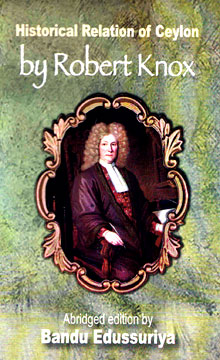The effort of Dr. Bandu Edussuriya in bringing out an abridged version of such an important and cerebral publication is a great need of the day. Undoubtedly, it is an arduous task. The significance of the publication relates to a number of reasons. Condensing of the original volume of Robert Knox (RK), himself a foreigner making an indomitable effort to capture the essence of the social, cultural and economic dimensions of the Kandyan Sinhala community, successfully, secondly contributing to the literature, the only recorded publication sociologically and culturally of the period during the 17th century, thirdly the authenticity of the facts due to his living with the Kandyans for over two decades, though in a sort of an ‘open prison’ in the Kandyan territory (perhaps the first ever open prison camp any where in the world!), fourthly highlighting the level of tolerance of the Sinhalese. The achievement of Dr. Bandu Edussuriya, from the discipline of medicine, should be highly appreciated for providing the reading public an abridged version of such importance.
The writer very cogently emphasises for whom the abridged version was developed. The focus has been very futuristic to include ‘children and modern day reader'. He very rightly avoids mentioning academia since the latter would prefer more details which are in the original. The modern readers are more concerned about time since there is no much of information and sources and lack of time to devote to details unless these are related to the work he/she is engaged. Furthermore, modus operandi related to travelling and logistics is far better than ever before that enables them to concentrate on less serious reading while travelling and during any space of time. Hence, short and abridged versions of even serious writings serve the voluptuous readers. Hence why there are similar short versions of books.
The abridged version of Robert Knox's ‘Historical Relations...’ printed in 1681, opens the door for the younger readers a glimpse of the recent past history, 17th century, about the Sinhala culture and insights to the fauna and flora, the interests and the care of the people on the natural phenomenon which provided sustenance for the communities. The abridged version (AV) consists of the 39 chapters in 4 parts in 128 pages, the full volume of the original publication. Written in simple language, each chapter is less than 10 pages, readable in less than 2 hours which ideally fits into the schedule of any commuter. The four parts consist of a) Part 1-chapter 1-14, background, capture, and imprisonment in Candy (Kandy), tolerant nature of the Candyans, Part 2-chapters 15-22, fauna, flora, fruits, precious stones, part 3 – chapters 23-28, The King’ nature, vices, recreation and religion, tyrannical nature of the king, revenues and treasurers, governors of the provinces, kings strengths, rebellion against the king, Part 4-chapters 29-39, inhabitants of the country, honour rank and qualities, religion, god and temples, gods and festivals, houses, diet, housewifery and salutation, lodging bedding, whoredom, marriages and children.
All of the above chapters provide the reader an inquisitiveness to probe in details as to how our ancient people lived, behaved and ruled. The ancient chronicles, both Mahavamsa and Chulawansa do not provide first hand information although both are used as important sources of our ancient history. This is true of countries that have similar historical records written down later, for centuries preserved in he minds of men. Hence, facts become blurred and distortions, contradictions do occur, unless these are supported by rock inscriptions and the like to substantiate the texts. Today, we use carbon tests and modern technology to verify the periods and scenarios of the past. In this background the book by Robert Knox is vital and valuable for us to know, almost first hand authentic information written by a person who experienced by living with the people and travelling all the time in the Kandyan territory without hindrances but all time planning his escape back to his motherland, UK.
The abridged version prepared by Dr. Bandu Edussuriya is also a valuable contributing towards motivating the younger readers to the study of the history and culture of Sri Lanka, who otherwise are engrossed with modern technology and rushing through life for want of time. Further, RK's publication indicates that even in dire straits one could be resourceful and be engaged while not giving up his desire to escape. The lesson of RK's publication for the younger generation of today is one of great importance. In that one could be creative and reflective contributing to social development without any resources at hand through a process of developing divergent thinking. Likewise it is also known that diaries of farmers who had recorded the daily routines and reflections of their activities meticulously have been used by scholars/researchers for their higher degrees, as well as for policy planning. The famous diaries of Government Agents of the past civil service in Sri Lanka is a case in point at a different level. RN's publication was also based on such routine recording of events.
The language of the publication is simple and could be easily understood by any one who has some competency in English. This abridged version of Robert Knoxs ‘Historical Relations of Ceylon’ could be recommended to all school libraries.
The author could have made a suggestion in this direction in the introduction as a matter of encouragement to writing taking the writing phobia out of the youth. I wish this abridged version is translated into Sinhala and Tamil.
- Dr S B Ekanayake



Add new comment